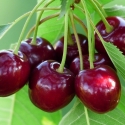Low Chill Cherries !!!
for North & Central Florida
Prunus avium
Low chill 'northern' cherries are a new experimental introduction for us for spring 2019. They are not for everybody --- but for those of you who understand the risks and would like to try them out, we have larger, healthier trees that will help you succeed. Because they are in pots and not bare root, the transition from nursery to gardener should be more successful for you.
Why not cherries?
We've had many requests for northern-type cherries for Florida: Prunus avium or "Bing-type" sweet cherries. But none of the professional growers in FL will propagate cherries because they are not recommended by IFAS. So we've been researching why or why not.
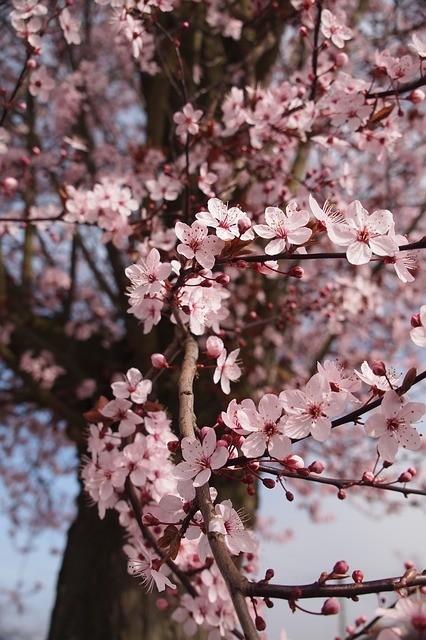
mature cherry tree in full bloom
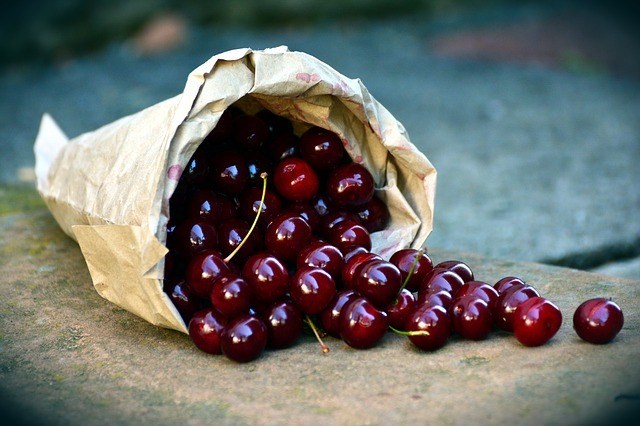
northern cherries: Prunus avium
IFAS research:
IFAS did some research on this some 25+ years ago with high chill varieties like the Bing and determined that cherries don't work in Florida -- and rightly so at the time. (sorry, I've lost the link)
The problems they ran into were many: too many chill hours needed (800 and up), blooms in April during our rainy season caused fungi to set in -- which destroyed the fruit when ripening, plus root rot from our wet soils in the summer, fruit flies from the warmer climate -- and all our general fungi issues and nematodes.
Our new choices:
In the last 20+ years, California growers have been very busy hybridizing sweet cherries!
We now have 4 varieties from Dave Wilson that need less than 400 chill hours and so are well suited to zone 9 temperatures: Lapins, Royal Lee & Minnie Royal, and Royal Crimson.
Since they are such low chill varieties, these 4 cherries should bloom out in February or early March at the latest, alongside the rest of the Prunus family in Florida: peaches, plums, and nectarines. And because February is usually much drier than April, that may take care of the fruit rot issue and the low chill issue at the same time.
Ripening times are mid May & early June.
more details: http://www.davewilson.com/search/cherry
Royal Lee & Minnie Royal:
These two should bloom in February and ripen approximately mid-May in Florida.
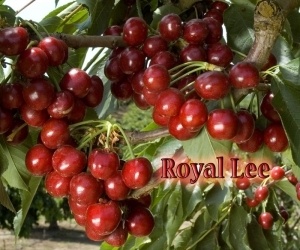
Royal Lee cherry only needs 250 chill hours to set fruit.
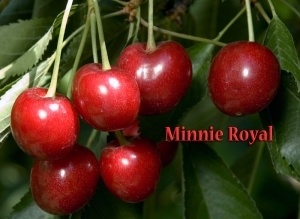
Minnie Royal cherry is a good pollinator for the Royal Lee cherries.
Lapins: known as "self fertile Bing", requires approx 350-400 chill hours to bloom. It is a large, firm, flavorful, dark red sweet cherry from Canada.
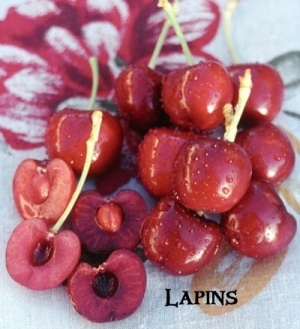
Lapins cherry: aka "self-fertile Bing"
Lapins' chill hour requirements should be compatible with planting in the Ocala / Gainesville area of Florida, in a line southwest to Brooksville, and everywhere to the north and west of that line, with the possible exclusion of mild areas of Jacksonville along the St Johns River waterway.
Lapins should bloom in February and ripen in late May to early June.
Royal Lee & Minnie Royal: need each other for pollination, and require approximately 250 chill hours to bloom. Fruit should be ripe approximately mid-May.
Royal Lee produces a medium-sized red fruit with excellent flavor, and is a highly productive tree. Chill hours are officially listed as "200-300" total. It is pollinated by the Minnie Royal.
Minnie Royal produces a medium-sized firm red fruit also with good flavor, and is a highly productive tree as well. Chill hours are officially "200-300" total, and is cross pollinated by the Royal Lee.
Planting zone for Royal Lee and Minnie Royal should include most of the northern half of Florida, from I-10 south to SR60, approximately. There will be questionable areas right on the coast where chill hours can be much milder, such as in Pinellas County (from Tarpon Springs to St Pete) or from Palm Bay / Malabar area south. If you chose to experiment in those areas, we would appreciate your feedback immensely so we can share with others. We do have confirmation of these growing in the Lakeland area.
Royal Crimson is a self-fruitful, very low chill hour sweet cherry. With an estimated chill hour requirement of just 200 to 300 hours (below 45 degrees), Royal Crimson makes an excellent pollenizer for both the Royal Lee and the Minnie Royal, increasing harvest where sporadic winters may cause an inconsistent overlap of blooming times.
The tasty, large, crimson red fruit ripens early to mid May. Suited to zones 8-10.
Developed by Zaiger Genetics & patent pending.
And new for 2020: (sweet) Royal Crimson
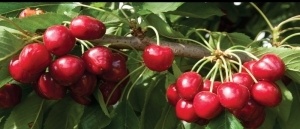
Royal Crimson is a large, sweet red cherry
Rootstocks and Fungi Issues.
As to the wet soils issue: we now have a new rootstock from France that is well suited to wet soils & even calcium rich soils (think Florida limestone!) called Maxma-14. And if we need to, we could even plant the cherry trees up on a little raised mound, much like we do our avocado trees in low lying areas, to ensure good drainage for the roots and never standing water on the roots.
Maxma-14 also induces early heavy fruiting, is resistant to both bacterial canker and nematodes, and tends to dwarf the tree to about 2/3's of standard size, so about 10-12' estimate. Sounds like a win-win.
We believe these cherries should begin to fruit about the third year on Maxma-14, from what we can learn so far.
read more at Dave Wilson here.
According to Dave Wilson Nursery, Mazzard root stock is the standard rootstock for cherries, and produces a full sized tree, whereas Maxma-14 dwarfs the tree to about 2/3's of full size.
Mazzard is also nematode resistant and reasonably tolerant of wet soils, but it sounds like Maxma-14 may be superior on both those characteristics.
Mazzard rootstock requires an extra year before the tree begins producing. Trees grafted to Mazzard generally fruit about year 4 or 5, whereas with Maxma-14, it is more likely to fruit in year 3. Both should be compatible with average Florida conditions, but we are ordering the majority of our cherry trees on Maxma-14 rootstocks.
We also now have the (modified / Texas, red) cedar oil product that corrects our soil fungi and nematode issues when used as a soil drench --- probably needs more than one application. We are recommending using the cedar oil as a soil drench 3-4x's a year to significantly reduce pests and pathogen issues. By the second spring, the lack of insect population explosions is very noticeable in our experience. Read more here.
So does it work?
We're not 100% sure yet, honestly.
But it's looking very promising.
We have reports of folks growing the Royal Lee & Minnie Royal in Lakeland and north of Ocala and getting fruit, even with benign neglect. And reports of failure from a nursery in FL, who "has clients that just want to plant and forget" (any wonder they died?) But no one has tried this on a large scale here yet, or with any degree of consistent nurturing with water and plant food.
All that said, cherries are still an experiment for Fl. We are not recommending them for the faint of heart -- yet. We need to trial these for 3-5 years minimum before we can begin to draw meaningful conclusions for long term success. Researchers wait 20 years to draw conclusions. I'm not that patient -- and can't keep a secret like this that long, nor do we have that much time.
But for all you risk takers out there who want to have cherry trees, we have some beautiful trees 6' tall with 1" diameter trunks, that are NOT bare root: they are in 15g pots ($99) with roots emerging from the pots by approximately March 15th each year. We've taken some of the risk out of the equation by having them already to the potted (i.e. rooted out) stage.
If you're buying them the same spring we've just received them, we're recommending leaving them in the pots until approx May 15 to June 1 at the latest, to be sure the roots are tight before transplanting. They are in our Magic Soil Formula dirt, and have had a NutriHold boost as well -- so they are growing quite vigorously. Otherwise, you'll want to plant cherries in the coolest months of the year, Sept to May, just like we do peaches, plums, and nectarines.
And keep them on daily drip irrigation throughout the 9 warm months of the year, feeding them with the organic soil amendments formula every month, just like you would apples or bananas.
Update April 2021:
So far, so good: trees appear to be adapting well, third spring. New growth each year is vigorous. Blossoms this spring on the 3yr old trees, no fruits set. But then we had a few too many squirrels to be sure . . . and now deer invading our space. Apparently cherries growing in organic soil are quite tasty!
Update Feb 2023:
Great progress! Trees are adapting well and thriving all over the state. Even a few trials in 100 chill hour areas are partially successful. More reports of blossoms on trees: from Dade City to the Panhandle. Isolated reports of fruits from Archer, High Springs and other areas in Central FL.
Update July 2024:
Looking very promising! Trees are continuing to do well and thriving all over zones 8 & 9. More reports of fruits from High Springs, Citra, Williston and other areas in Central FL. New report from 6yr old+ trees fruiting well in Mayo, and mature trees in Ocala as well.
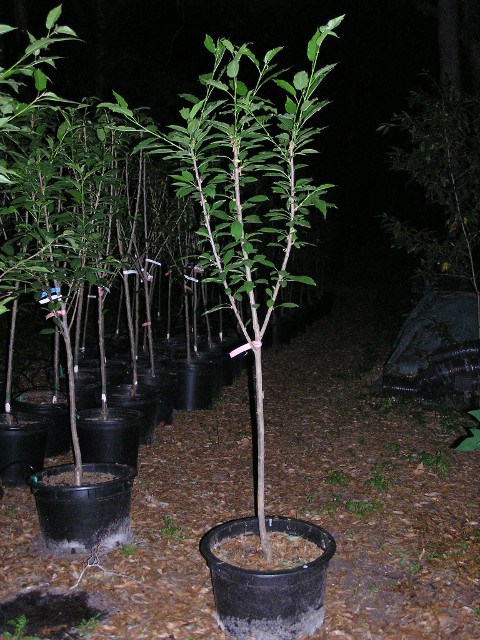
2yr old 15g Royal Lee cherry tree at 8wks in the pot

2 yo / 15g Minnie Royal cherry tree, 8wks in the pot
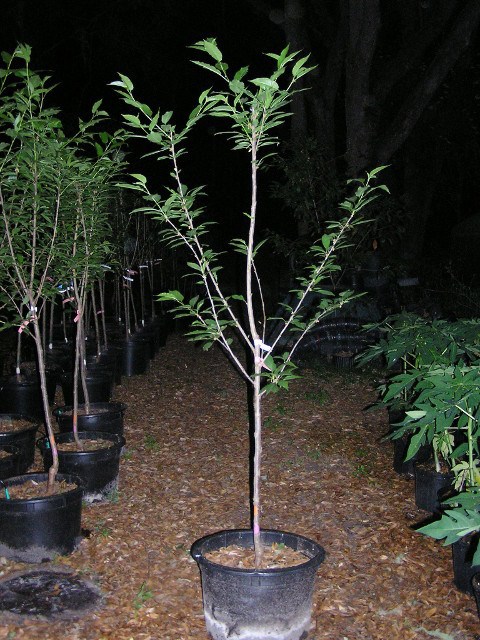
2yr old / 15g Lapins Cherry tree, 8wks in the pot
Update June 2024:
2yo trees:
all varieties are in stock
3yo trees maybe in January
pls ask / email b/4 ordering
HOW TO PRUNE
A YOUNG (SWEET) CHERRY TREE
See our latest blog post on pruning sweet cherries, year 1 to year 4 and beyond here. includes video!

